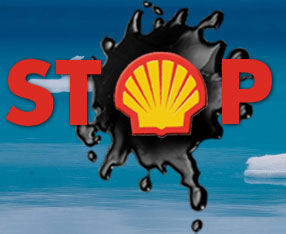 In July, barring any last minute legal challenges, oil giant Shell looks set to cross the rubicon and start drilling offshore in the Arctic.
In July, barring any last minute legal challenges, oil giant Shell looks set to cross the rubicon and start drilling offshore in the Arctic.
Many environmentalists and indigenous communities have long fought and feared this day.
Many of the veterans of the Exxon Valdez have long argued that the lessons of that disaster have still not been heard and that twenty three years later we are still not prepared for a major spill in the Arctic.
The Exxon Valdez veterans were joined two years ago by thousands of others who watched in horror as BP’s black tide engulfed the Gulf of Mexico.
In 2011, President Obama’s Deepwater Horizon commission urged the President to exercise the “utmost caution,” with regard to Arctic drilling.
In a follow-up report last month, the commission reiterated that there is still no proven method for cleaning oil spilled in ice. They noted that the Coast Guard lacks an adequate response capability in the region.
Many people had hoped that America would heed voices of caution and learn from the Exxon Valdez and Deepwater Horizon and never drill offshore in the Arctic.
Many reasoned that a democratic president would never allow drilling anyway.
But the President does not seem to be listening to his own advisors. He is listening to the oilmen.
“We never would have expected a Democratic president — let alone one seeking to be ‘transformative’ — to open up the Arctic Ocean for drilling,” says Michael Brune, executive director of the Sierra Club.
The oil industry always plays the long game. It has the money and power to do so, whereas its critics can burn out diminish as time and lack of resources takes its toll.
Take Shell. The oil giant’s massive, multi-billion dollar lobbying campaign was explored in a great article in last week’s New York Times.
The company has spent a cool $4 billion over seven years to open up the Arctic.
Such is Big Oil’s huge financial weight that the paper points out that drilling offshore in the Arctic in waters “previously considered untouchable had gone from improbable to inevitable.”
The paper adds that it is “moment of major promise and considerable danger.” But so often with the industry the promises are overhyped and the dangers undersold.
The company has employed a classic two-fronted public relations campaign. On the one hand it has divided the opposition and on the other it has pushed its “responsible” image.
Firstly it won over the Inuit community, by sending in lobbyists and using the Eskimo business community as “third parties” to push its message. These were used to try and divide and rule the opposition.
At the same time, the company tried to look responsible on climate change, joining the United States Climate Action Partnership, a coalition of businesses and environmental groups calling for action on global warming.
The New York Times describes this as “a canny move, calculated to gain access to top policy makers, including the president.”
Federal agencies were bombarded by big oil lobbyists. “Some bureaucrats felt under siege by the relentless lobbying,” noted the paper. “I understood they were doing it, I understood why they were doing it, and it wasn’t as subtle as it should have been,” one regulator told the Times, “I didn’t like it.”
Shell looks like it has bullied its way to getting drilling in the Arctic.
Despite their rhetoric, the company will be unprepared for a spill. One local whaling captain told the paper: “Those oil guys can think whatever they want, but we know how harsh this ocean is. They don’t know what they are getting into.”

Climate change is THE issue of our times. Shell has corrupted our government to allow acceleration of climate change by drilling for oil in the arctic.
Seattle has now become the line in the sand. We are urging all environmentalists to come to Seattle this month and next to stop Shell. See shellno.org